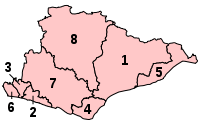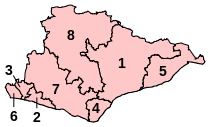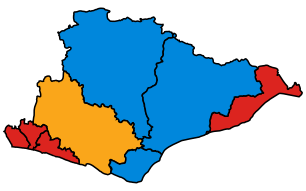List of Parliamentary constituencies in East Sussex
The ceremonial county of East Sussex, (which includes the unitary authority of Brighton & Hove) is divided into 8 Parliamentary constituencies - 4 Borough constituencies and 4 County constituencies.
Constituencies
Conservative † Labour ‡ Liberal Democrat ¤ Green Party ♣
| Constituency[nb 1] | Electorate[1] | Majority[2][nb 2] | Member of Parliament[2] | Nearest opposition[2] | Electoral wards[3][4] | Map | ||
|---|---|---|---|---|---|---|---|---|
| Bexhill and Battle CC | 81,963 | 26,059 | Huw Merriman † | Christine Bayliss ‡ | Rother District Council: Battle Town, Central, Collington, Crowhurst, Darwell, Ewhurst and Sedlescombe, Kewhurst, Old Town, Rother Levels, Sackville, St Marks, St Michaels, St Stephens, Salehurst, Sidley, Ticehurst and Etchingham. Wealden District Council: Cross In Hand/Five Ashes, Heathfield East, Heathfield North and Central, Herstmonceux, Ninfield and Hooe with Wartling, Pevensey and Westham. |  | ||
| Brighton, Kemptown BC | 69,833 | 8,061 | Lloyd Russell-Moyle ‡ | Joe Miller † | Brighton and Hove City Council: East Brighton, Moulsecoomb and Bevendean, Queen’s Park, Rottingdean Coastal, Woodingdean. Lewes District Council: East Saltdean and Telscombe Cliffs, Peacehaven East, Peacehaven North, Peacehaven West. |  | ||
| Brighton, Pavilion BC | 79,057 | 19,940 | Caroline Lucas ♣ | Adam Imanpour ‡ | Brighton and Hove City Council: Hanover and Elm Grove, Hollingbury and Stanmer, Patcham, Preston Park, Regency, St Peter’s and North Laine, Withdean. |  | ||
| Eastbourne BC | 79,307 | 4,331 | Caroline Ansell † | Stephen Lloyd ¤ | Eastbourne Borough Council: Devonshire, Hampden Park, Langney, Meads, Old Town, Ratton, St Anthony’s, Sovereign, Upperton; Wealden District Council: Willingdon |  | ||
| Hastings and Rye CC | 80,524 | 4,043 | Sally-Ann Hart † | Peter Chowney ‡ | Hastings Borough Council: Ashdown, Baird, Braybrooke, Castle, Central St Leonards, Conquest, Gensing, Hollington, Maze Hill, Old Hastings, Ore, St Helens, Silverhill, Tressell, West St Leonards, Wishing Tree. Rother District Council: Brede Valley, Eastern Rother, Marsham, Rye. |  | ||
| Hove BC | 74,313 | 17,044 | Peter Kyle ‡ | Robert Nemeth † | Brighton and Hove City Council: Brunswick and Adelaide, Central Hove, Goldsmid, Hangleton and Knoll, North Portslade, South Portslade, Stanford, Westbourne, Wish. |  | ||
| Lewes CC | 71,503 | 2,457 | Maria Caulfield † | Oli Henman ¤ | Lewes District Council: Barcombe and Hamsey, Chailey and Wivelsfield, Ditchling and Westmeston, Kingston, Lewes Bridge, Lewes Castle, Lewes Priory, Newhaven Denton and Meeching, Newhaven Valley, Newick, Ouse Valley and Ringmer, Plumpton, Streat, East Chiltington and St John (Without), Seaford Central, Seaford East, Seaford North, Seaford South, Seaford West. Wealden District Council: Alfriston, East Dean, Polegate North, Polegate South. |  | ||
| Wealden CC | 82,998 | 25,655 | Nus Ghani † | Chris Bowers ¤ | Wealden District Council: Buxted and Maresfield, Chiddingly and East Hoathly,
Crowborough East, Crowborough Jarvis Brook, Crowborough North, Crowborough St. Johns, Crowborough West, Danehill/Fletching/Nutley, Forest Row, Framfield, Frant/Withyham, Hailsham Central and North, Hailsham East, Hailsham South and West, Hartfield, Hellingly, Horam, Mayfield, Rotherfield, Uckfield Central, Uckfield New Town, Uckfield North, Uckfield Ridgewood, Wadhurst. |
 | ||
Boundary changes
| Name | Pre-2010 Boundaries | Post-2010 Boundaries |
|---|---|---|
 Parliamentary constituencies in East Sussex |
 Proposed Revision | |
Current proposals by the Boundary Commission for England would retain these 8 constituencies, with changes to realign constituency boundaries with the boundaries of current local government wards, and to reduce the electoral disparity between constituencies. These changes will be implemented at the 2010 United Kingdom general election.
Proposed boundary changes
The Boundary Commission for England submitted their final proposals in respect of the Sixth Periodic Review of Westminster Constituencies (the 2018 review) in September 2018. Although the proposals were immediately laid before Parliament they were not brought forward by the Government for approval. Accordingly, they did not come into effect for the 2019 election which took place on 12 December 2019, and which was contested using the constituency boundaries in place since 2010.
Under the terms of the Parliamentary Voting System and Constituencies Act 2011, the Sixth Review was based on reducing the total number of MPs from 650 to 600 and a strict electoral parity requirement that the electorate of all constituencies should be within a range of 5% either side of the electoral quota.
On 24 March 2020, the Minister of State for the Cabinet Office, Chloe Smith, issued a written statement to Parliament setting out the Government's thinking with regard to parliamentary boundaries. They propose to bring forward primary legislation to remove the statutory obligation to implement the 2018 Boundary Review recommendations, as well as set the framework for future boundary reviews in time for the next review which is due to begin in early 2021 and report no later than October 2023. It is proposed that the number of constituencies now remains at the current level of 650, rather than being reduced to 600, while retaining the requirement that the electorate should be no more than +/- 5% from the electoral quota.[5]
Results history
Primary data source: House of Commons research briefing - General election results from 1918 to 2019[6]
2019
The number of votes cast for each political party who fielded candidates in constituencies comprising East Sussex in the 2019 general election were as follows:
| Party | Votes | % | Change from 2017 | Seats | Change from 2017 |
|---|---|---|---|---|---|
| Conservative | 197,728 | 44.2% | 5 | ||
| Labour | 121,935 | 27.3% | 2 | 0 | |
| Liberal Democrats | 75,754 | 16.9% | 0 | ||
| Greens | 45,128 | 10.1% | 1 | 0 | |
| Brexit | 4,738 | 1.1% | new | 0 | 0 |
| Others | 1,898 | 0.4% | 0 | 0 | |
| Total | 447,181 | 100.0 | 8 |
Percentage votes
| Election year | 1983 | 1987 | 1992 | 1997 | 2001 | 2005 | 2010 | 2015 | 2017 | 2019 |
|---|---|---|---|---|---|---|---|---|---|---|
| Conservative | 58.4 | 57.8 | 52.8 | 39.4 | 39.6 | 39.8 | 40.9 | 42.3 | 44.3 | 44.2 |
| Labour | 13.6 | 15.2 | 17.5 | 29.2 | 30.2 | 25.4 | 20.1 | 22.9 | 32.2 | 27.3 |
| Liberal Democrat1 | 27.2 | 26.3 | 27.5 | 24.0 | 24.0 | 26.3 | 28.0 | 12.9 | 14.1 | 16.9 |
| Green Party | - | * | * | * | * | * | 5.7 | 10.1 | 7.8 | 10.1 |
| UKIP | - | - | - | * | * | * | 2.8 | 11.6 | 1.3 | * |
| Brexit Party | - | - | - | - | - | - | - | - | - | 1.1 |
| Other | 0.9 | 0.7 | 2.1 | 7.4 | 6.2 | 8.6 | 2.4 | 0.3 | 0.3 | 0.4 |
11983 & 1987 - SDP-Liberal Alliance
* Included in Other
Seats
| Election year | 1983 | 1987 | 1992 | 1997 | 2001 | 2005 | 2010 | 2015 | 2017 | 2019 |
|---|---|---|---|---|---|---|---|---|---|---|
| Conservative | 8 | 8 | 8 | 3 | 3 | 3 | 5 | 6 | 4 | 5 |
| Labour | 0 | 0 | 0 | 4 | 4 | 4 | 0 | 1 | 2 | 2 |
| Liberal Democrat1 | 0 | 0 | 0 | 1 | 1 | 1 | 2 | 0 | 1 | 0 |
| Greens | 0 | 0 | 0 | 0 | 0 | 0 | 1 | 1 | 1 | 1 |
| Total | 8 | 8 | 8 | 8 | 8 | 8 | 8 | 8 | 8 | 8 |
11983 & 1987 - SDP-Liberal Alliance
Maps
 1997
1997 2001
2001 2005
2005 2010
2010 2015
2015 2017
2017 2019
2019
Historic representation by party
See West Sussex for table of whole of Sussex.
Notes
- BC denotes borough constituency, CC denotes county constituency.
- The majority is the number of votes the winning candidate receives more than their nearest rival.
References
- Baker, Carl; Uberoi, Elise; Cracknell, Richard (2020-01-28). "General Election 2019: full results and analysis". Cite journal requires
|journal=(help) - "Constituencies A-Z - Election 2019". BBC News. Retrieved 2020-04-24.
- "The Parliamentary Constituencies (England) Order 2007, page 4". Office of Public Sector Information. Crown copyright. 13 June 2007. Retrieved 7 November 2009.
- Boundary Commission for England pp. 1004–1007
- "Update: Strengthening Democracy:Written statement - HCWS183". UK Parliament. Retrieved 2020-04-20.
- Watson, Christopher; Uberoi, Elise; Loft, Philip (2020-04-17). "General election results from 1918 to 2019". Cite journal requires
|journal=(help)